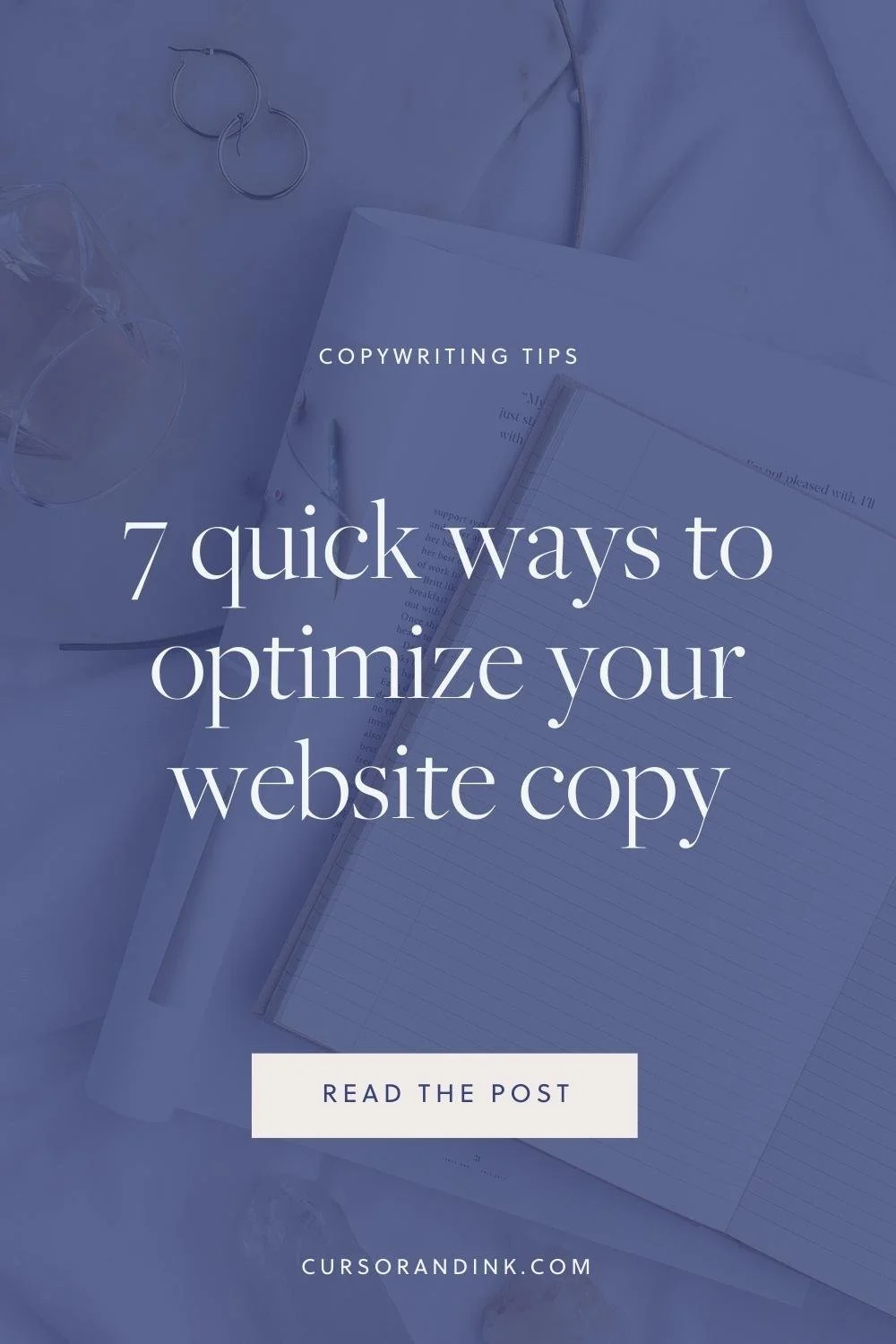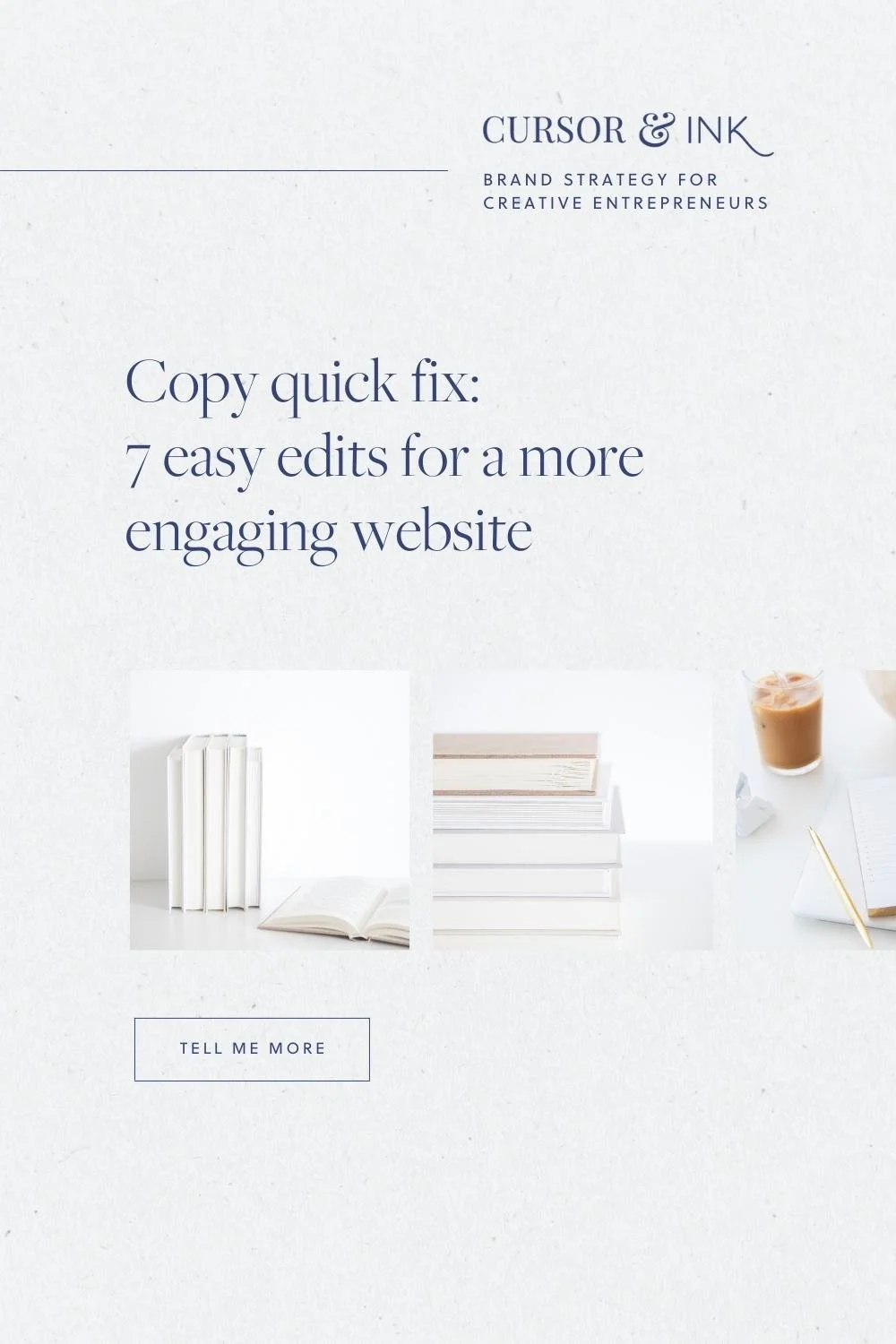Website quick wins: 7 easy ways to update your website copy today
Updating your website copy can be a massive project — and while it also has an enormous payoff, the reality is that sometimes you don’t have the time to revamp everything from scratch.
So what do you do when you know your website words could use a little love, but you don’t want to start from square one?
Option One is to go one page at a time. If that sounds like an approach you might want to take, start with the four most important pages on your website and rework them using the tips I share in this post.
Option Two is what I want to talk about today. In this post, I have seven tips for optimizing the copy you already have with small, strategic tweaks that will increase engagement and conversions. Here’s the shortlist — click the links to jump to the appropriate section, or keep scrolling to dig in!
1 - Get clear on your value proposition
How would you reply to the question, “Why should your customers choose you over anyone else?”
Your answer is your value proposition — and you should be talking about it on every page of your website.
That doesn’t mean that you need to say the same words repeatedly. Instead, think about it as a narrative — a story you’re telling that starts on the Home page, then extends through your About page, your Products or Services pages, and into your portfolio, blog, contact page, and everywhere else.
Take a look at your home page copy first. Is your value proposition clearly stated at the very top of the page? (This is called “above the fold”, as if it were the top headline of a crisply folded newspaper.)
Now imagine that you are weaving that thread down the page and through the rest of your site, showing different aspects of that big idea, what it means to you (your About page), and how you serve your clients or customers (the products and services pages). How can you repeat that value proposition on your other pages to clearly show prospective clients the value of choosing you?
2 - Rework your headlines (and sub-heads)
Chances are, your readers aren’t reading every word of your site. In fact, studies have shown that they’re reading at most 28%. (Source: Nielsen Norman Group)
The thing they are reading is your headlines.
A good headline creates a hit-the-brakes moment that grabs your reader’s attention. Its only job is to get you to stop and read what comes next — i.e., the sub-head. The sub-head’s job is to get your reader to stick around and read the body copy. Together, they hook your reader, slow them down, and increase engagement.
Reworking your headlines and sub-heads to capture attention, show value, and keep the reader moving down the page is a great way to optimize your copy. Aim for headlines that:
Spark curiosity or surprise
Say what the reader is thinking
State the value or transformation you offer
Then, finish by optimizing the CTA at the end of that section to line up with the hook in your headline and show the reader how they can take action.
Which brings us to…
3 - Optimize your CTAs
If the buttons on your website read like a parade of “Learn more,” “Submit,” and “Buy Now,” stop your scroll — this one’s for you.
Calls to Action (CTAs) are a massive quick-win opportunity for optimizing your website copy. After all, almost every conversion starts with the click of a button — whether that’s clicking to purchase, book a call, or sign up for your newsletter. Making sure your button copy is clear and compelling is a great way to get your readers to act.
Every button or CTA should do two things:
Tell your reader what to expect. What will they see or get? Being clear about what happens after they click will ease any anxiety and make them feel more in control.
Remind them that they’re getting something that they want. How does this solve a problem, meet a need, or give them a solution?
A good formula to work with is: [ Action word ] + [ desired outcome / transformation / deliverable ]
Not sure what that outcome/transformation is? Imagine how the reader would finish the sentence, “I want to…”
For example:
Start saving money
Get access now
Send me the free guide
Choose action words that feel easy and exciting, like “Get,” “Try,” “Open,” “Watch,” and “Discover.” Avoid anything that feels too much like work or effort: “Buy,” “Order,” “Register,” or “Submit.”
Another tip: write in the first person for the reader — i.e. “Start my free trial” is better than “Start your free trial.”
4 - Speak to benefits, not just features
You know the ins and outs of our offering, and your website is the perfect place to show off exactly how it works. But are you showcasing why it matters?
Features are all about “what’s in the box” when it comes to your product or service. Benefits, on the other hand, are about the customer. They answer the all-important question: “What’s in it for me?” Don’t just tell your customers about a particular feature; show them how it will improve their life or business.
One way to present this: [ feature ] so that [ benefit ]
For example:
Branded social media templates so that your new brand is effortlessly consistent everywhere you post
24/7 customer support so that any questions or issues you have are resolved ASAP
Regular progress updates so that you’re always in the know about where we’re at and what’s coming next
5 - Reformat for scanners
We’ve already talked about the importance of headlines in helping readers as they scan. But there are other tweaks you can make to help your quick-skimming audience find what they need and stay engaged.
If you have wordy sections or long, unbroken blocks of text, try some of these editing tricks:
Place the most important information upfront so that readers don’t miss it
Use bulleted lists to break up information into more digestible (and skimmable) chunks
Use bold and italics to draw the eye to significant pieces of text
Add imagery to break up the page and give the eye something else to focus on (don’t just think standard photography here — infographics and video are also great options)
Break long paragraphs up into shorter ones (even single sentences!)
Use plain language that keeps things concise and straightforward (I like Hemingway for this)
6 - Add or update social proof
Consumers face more and more choices every day — and social proof is more important than ever as a factor influencing how people buy. Testimonials have been shown to increase conversion by 34%, and 80% of consumers say they’d be more likely to purchase a product from a online store if its website had photos and video from real customers.
Social proof can be a mix of things: testimonials, case studies, reviews, and stats that showcase your authority are the most common. Together, they form a powerful persuasion tool that can build trust and reassure potential clients they’re making the right choice.
And while updating testimonials and other forms of social proof like reviews or case studies can be easy to kick down your to-do list, it’s important. Here are a few ways you can keep them fresh:
Add in new testimonials or remove any that are outdated or no longer reflect your services or value proposition
Add photos or video where you can!
Look for spots on your website where you’re making a claim that could benefit from some “outside proof” to back up your message
Look for areas where you could make your social proof more visible and eye-catching
7 - Remove unnecessary or outdated content
Keeping your website fresh and relevant isn’t just about adding new content. Updating or removing old, unnecessary, or outdated information is essential to keep your message clear and focused. Outdated content can confuse visitors and detract from your current offerings.
Review your most visited pages and note any areas that don’t reflect your current offering, brand voice, or audience pain points. And if you have a blog, don’t forget to look at the archives: anything that isn’t accurate or on brand should probably go.
Next steps
And there you have it! Seven bite-sized strategies to update your website copy and make it work harder for your business without a complete overhaul. Try choosing three or four that you can implement over the next month or so — one every week or two.
And if you need more help with website copy updates, please reach out any time! Here are a couple ways I’d love to lend a hand:
If you have a list of tweaks you want done, but don’t want to do them yourself, let’s knock them off during a Brand Retreat Day!
Need comprehensive brand messaging + website copywriting support? The Brand Strategy Blueprint is the way to go.
Reach out today to book a free discovery call where I can answer any questions and help you decide which option is right for you!













